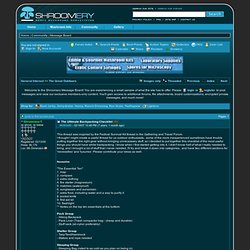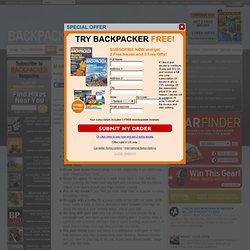

The Ultimate Backpacking Checklist - The Great Outdoors. This thread was inspired by the Festival Survival Kit thread in the Gathering and Travel Forum.I thought I might create a useful thread for us outdoor enthusiasts.. some of the more inexperienced sometimes have trouble putting together the right gear without bringing unnecessary stuff, so I decided to put together this checklist of the most useful things you should have while backpacking.

I know when I first started getting into it, I didn't know half of what I really needed to bring, and I brought a lot of stuff that I never needed. I'll try and break it down into categories.. and have two different sections for 'necessities' and 'luxuries'. Please contribute your ideas as well. Necessities "The Essential Ten"1. map2. compass3. extra clothing4. fire starter (magnesium)5. matches (waterproof)6. sunglasses and sunscreen7. extra food, including water and a way to purify it8. pocket knife9. first aid kit10. flashlight** Notes on the top ten essentials at the bottom Summary A word on clothes.
Backpacking Food. Back to Adventure Alan's Ultralight Backpacking Home Page: This contains a wealth of information on backpacking with gear lists, trip reports, backpacking techniques for various weather and environments (cold rainy weather, alipine hiking, desert hiking), etc.

While focused on lightweight backpacking, much of the content applies to all styles of backpacking. Sample Food Lists New for 2008: and updated Sample Food List for a 5 day 4 night backpacking trip. (PDF file) A sample no-cook food list spread sheet from my 2000 Rockies Trip — 5 days 4 nights. (HTML) Overview Keep it simple: My thoughts on backpacking food are not for all. Take 125 to 130 calories/ounce of food - Maintain nutrition: Try to get the most calories per unit weight in your food but not at the expense of a poor diet. Cooking and Stoves For green reasons, I am not fond of non-refillable, non-recyclable canister stoves. What types of food should I take? Snacks GORP: In the past, my basic food was the old standby GORP. Breafasts. Ultralight Backpacking. Make Your Sleeping Bag Warmer. Backpacker Magazine – February 2007 by: Jason Stevenson Don't get cold feet at the prospect of winter backpacking.

With the right insulation, food, and clothing, even chilly sleepers can snooze soundly through a freezing night. Follow our field-tested advice and set up your sleeping bag as shown below to create a comfortable cocoon that dries your damp clothes with body heat, and ensures all-night warmth. Size your sack You don't need a -40°F bag to sleep toasty, but you do need a snug fit; a too-big bag means extra space to heat, which saps your body's energy. Return to the Backpacking 101 home page. Pack a Backpack for Camping. From Wired How-To Wiki A well-packed sack will save your back.

Photo by The Glasshalffull via Flickr. It's happened to everyone before. You start out in the comfort of your living room, with a cavernous empty backpack and all your gear spread out before you. Then, six miles out, you realize: Despite stuffing your pack to the brim, you've forgotten your rain shell and soaked your food in fuel. This article is part of a wiki anyone can edit. Outside In Especially with a lightweight backpack, you should put your sleeping pad in first.
Sleeping bag next Pack in the reverse order of stuff you'll need. Distribute your supplies. Backpacking versus Thru-hiking.